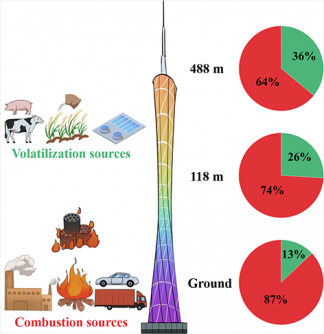URGENT UPDATE: Researchers from Jinan University have just unveiled critical findings that link combustion-related activities to elevated atmospheric ammonia levels in the Pearl River Delta (PRD), China. This groundbreaking study, released in the Frontiers of Environmental Science & Engineering, reveals the pressing need to understand the air quality challenges facing one of the world’s most densely populated regions.
The study highlights that ammonia (NH3) is a significant precursor to harmful fine particulate matter (PM2.5), which poses serious health risks. Using advanced sampling techniques, researchers collected PM2.5 samples at various heights—ground level, 118 m, and 488 m—from the iconic Canton Tower, the tallest structure in the region. The findings indicate that the average concentrations of ammonium ions (NH4+) were measured at 2.7 ± 1.4, 3.0 ± 1.8, and 2.6 ± 1.7 μg/m³ across the heights, showcasing no significant differences among them.
However, the nitrogen isotope composition revealed a vital correlation with altitude, suggesting that the sources of ammonia emissions are influenced by atmospheric height. The researchers utilized a Bayesian Isotope Mixture Model to assess the contributions of various sources, confirming that combustion processes are dominant in this area.
The breakdown of ammonia sources at ground level was alarming: emissions from agriculture contributed 9.9% ± 4.4%, waste 8.3% ± 5.5%, vehicles 29% ± 8.0%, biomass burning 16% ± 2.2%, NH3 slip 25% ± 6.0%, and coal combustion 12% ± 3.4%. In contrast, emissions from higher altitudes remained consistent, underscoring the limited impact of local activities at 488 m.
These findings underscore a critical public health concern, as residents of the PRD, home to over 60 million people, face rising air pollution levels that can exacerbate respiratory issues and other health problems. With the PRD being a major economic hub, addressing these pollution sources is crucial for both environmental sustainability and public health.
As the study emphasizes the urgent need for action against combustion emissions, stakeholders are urged to develop innovative strategies to mitigate pollution in the region. The implications of this research extend beyond local borders, raising alarm for other urban areas grappling with similar air quality challenges.
For those interested in the full details of this significant research, the complete paper is accessible at: Frontiers of Environmental Science & Engineering.
Stay tuned for further updates as researchers continue to monitor the atmospheric changes in the Pearl River Delta.







